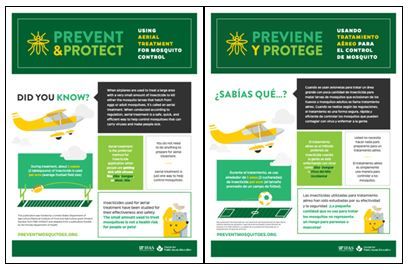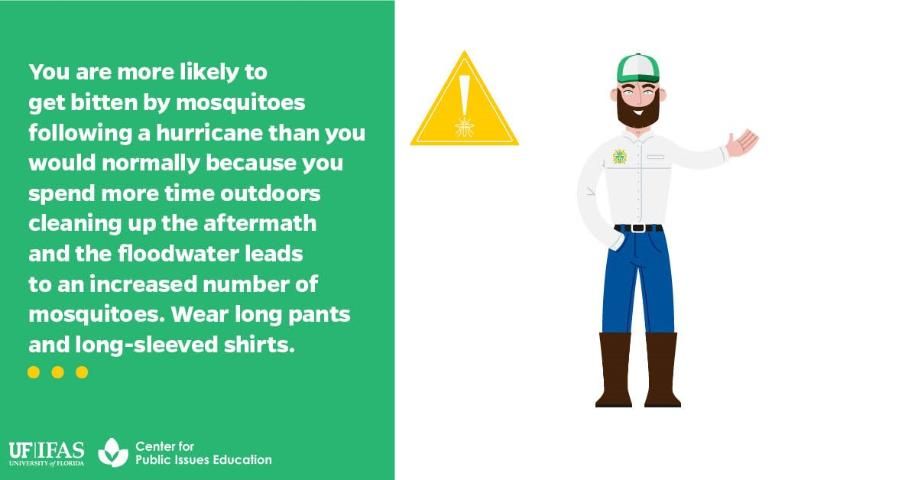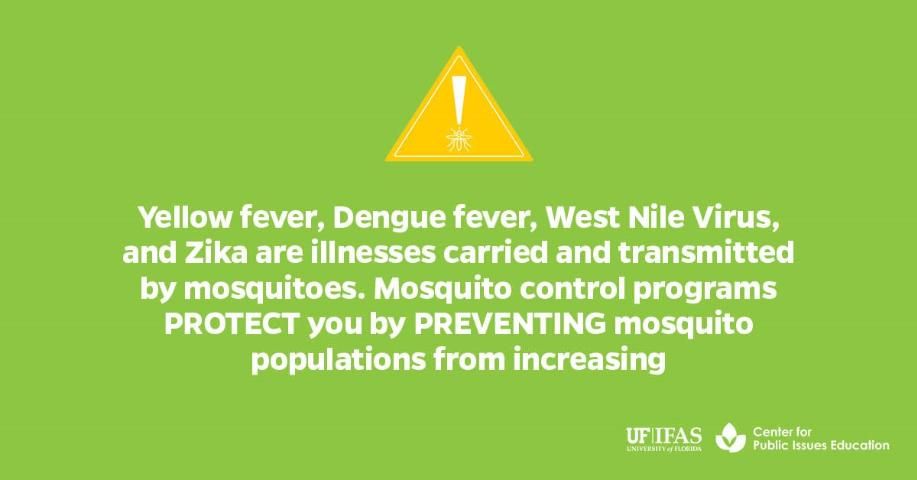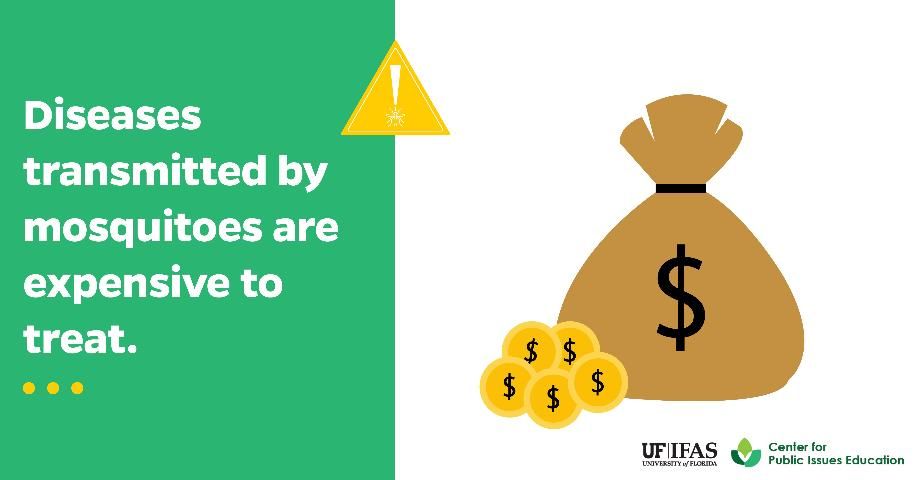Prevent & Protect Series Overview
The Prevent & Protect publication series focuses on the creation of different material formats to resonate with various audiences and ways to maximize efficacy in communicating with the public about mosquito-related risks and mosquito control topics. The UF/IFAS Center for Public Issues Education in Agriculture and Natural Resources (PIE Center) created the Prevent & Protect project to educate local elected and appointed officials and targeted audiences about mosquito control in a simplified, understandable format to increase public understanding of scientific information on the topic. The overview of the Prevent & Protect project can be found in the EDIS publication Public Perceptions of Mosquitoes and Mosquito Control (https://edis.ifas.ufl.edu/wc357). This document explains how to effectively use social media to communicate in an emergency situation specifically related to mosquito control. This publication also provides details on how to integrate the Prevent & Protect emergency toolkit in a mosquito-related emergency situation.
Mosquito Risks
Beyond being a nuisance, mosquitoes can also pose a great deal of risk to community health as transmitters of disease. Mosquitoes and other vectors, such as ticks, cause almost 700,000 deaths worldwide per year, making mosquitoes the most common vector of disease (World Health Organization [WHO], 2017). Various mosquito species can infect people with a range of diseases, including Zika virus, West Nile, chikungunya, dengue, and malaria (Centers for Disease Control and Prevention, 2019). Risk communication regarding mosquitoes is important year-round, but especially in times of emergency, such as during a disease outbreak or after a natural disaster, when standing water increases breeding grounds.
There are several reasons why an organization should be prepared to communicate about mosquitoes and mosquito control in an emergency situation. People are at risk of mosquito bites in these emergency situations. It is also the time when people are more likely to be actively seeking information on mosquitoes and mosquito control. Your communications goal may be to raise awareness about the dangers of increased mosquito populations and the benefits of mosquito control, particularly in emergency situations, without causing unnecessary panic.
As part of the 2019 Prevent & Protect project, 500 Floridians answered an online survey regarding their opinions on and knowledge of mosquitoes and mosquito control. Similar questions were also asked to participants at eight focus groups held in four different locations across the state. Overall, survey respondents were not very concerned about mosquito control, had not really thought about mosquito control, and had not actively researched information regarding mosquito control in their communities. When further discussing diseases that mosquitoes carry, several participants in each of the focus groups indicated their interest and concern with mosquitoes and mosquito control would intensify if there were a disease outbreak in their community or if they knew someone had contracted a disease from a mosquito. Through further prompts in the focus groups, participants indicated that an outbreak in their communities would spur them to seek out further information as well. These results are similar to the findings from the general public survey where, on average, Florida residents agreed most that controlling the mosquito populations in Florida is important because it protects Florida residents from mosquito-borne illnesses.
Putting Together a Social Media Plan to Communicate about Risk
In regard to mosquitoes and mosquito control, it is best to have a communications plan with two components: (1) a general plan that you can use to help the public understand the issues associated with a certain risk year-round (risk communication) and (2) a plan that can be rolled out in times of crisis (crisis communication). Risk communication deals with issues that have the potential to cause harm. In the case of mosquitoes, is important to communicate how mosquito control reduces the risk of damaging effects of mosquitoes year-round. Crisis communication deals with things that have gone wrong. In an emergency or crisis situation, such as a disease outbreak or the aftermath of a natural disaster, an organization's communications will be dealing with things that have already gone wrong and are actively causing harm or increased risk to the community's well-being. More information on the differences between risk and crisis can be found in the EDIS publication Risk and Crisis Communication: When Things Go Wrong (https://edis.ifas.ufl.edu/wc093).
In the case of the Prevent & Protect project, the four mosquito-related issues chosen to focus on year-round in the "general plan" (risk communication), based on survey and focus group results, were (1) personal responsibility and at-home mosquito control methods, (2) mosquito-borne illnesses, (3) the impact of mosquitoes as a nuisance and on the economy, and (4) different application methods utilized by mosquito control professionals. The plan for each topic includes a week's worth of social media posts with graphics and suggested text. These plans are all available for free to download and use at https://preventmosquitoes.org/mosquito-control-toolkit/.
When using social media to communicate about risk, follow these suggestions:
- Keep your posts brief. Some social media platforms, such as Twitter, will limit posts to a maximum amount of characters. Even on platforms without such restraints, if a post is too long, your audience will lose interest and either skim or skip over it altogether.
- Include a graphic. People are more likely to stop and engage with a post that has a graphic than one that only includes text.
- Use hashtags strategically. When used correctly, hashtags can connect your post to a larger audience of people searching for information on the same subject. However, it is important to consider the platform you are using, the relevance of the hashtags, and the amount.
- Include a call to action. Effective posts will give your audience a specific direction to take. Some examples of common calls to action include directing them to follow you on social media, to follow a link to read an article for additional information, or in the case of risk communications, to take a simple action to reduce personal risk, such as turning over containers that could hold water and be a habitat for mosquito development.
Consider the culture of your target audience. For example, when creating the outreach materials and social media posts on aerial application for mosquito control, a football field was used to demonstrate the size of the area in the English version, but a soccer field was used for the Spanish and Haitian Creole versions of the materials because the audience is more familiar with soccer (fútbol) than American football (see Figure 1).

Credit: Prevent & Protect
Putting Together a Social Media Plan to Communicate about Crisis
If you are a part of an organization that communicates about mosquitoes, mosquito control, public health, or general community concerns, it is important to have an established plan in place for how you will communicate about mosquitoes in an emergency. This plan should differ from general risk communications by creating a greater sense of urgency and focusing on immediate actions that an individual can take to protect themselves and those around them. One reason that social media serves as an effective tool for communicating in a crisis situation is that people may not have the time or capability to research and read longer publications or sift through an organization's website to find the information they require.
To help organizations that may need to communicate about mosquito control in emergency situations, Prevent & Protect created two emergency-related social media plans; one is to be used following a natural disaster, and the other is to be implemented during a disease outbreak. Each plan (disease and natural disaster) includes a schedule of five social media posts and accompanying graphics. Each post can be edited to include a county logo. The social media plans are available for download at https://preventmosquitoes.org/emergency-response-toolkit/.
In the remainder of this section, suggestions on communications in an emergency situation will be illustrated with examples from the Prevent & Protect emergency toolkit:
- Convey a greater sense of urgency. The goal is no longer to increase the public's general knowledge or awareness of the issue and overall risk mitigation efforts. The threat is now specific and needs to be addressed quickly and efficiently. This post from the natural disaster emergency toolkit explains concisely why increased mosquito control efforts are now necessary and gives the public an actionable way to protect themselves (see Figure 2).

Credit: Prevent & Protect
- Don't cause panic. While it is important the public takes the issue seriously, do not communicate in a way that causes panic. Stick to the facts and avoid misinformation or sensationalism. The following post from the Prevent & Protect emergency toolkit states the facts in an easy-to-understand way, relaying important information about the range of diseases mosquitoes can carry, without the use of fear tactics (see Figure 3).

Credit: Prevent & Protect
- Don't let the risk remain abstract. By connecting the risk of mosquitoes to specific and concrete concerns people may have, such as economic, community health, or quality of life costs, a communications plan will draw their interest more. This post taken from the Prevent & Protect emergency toolkit for disease outbreak emphasizes both the health costs of a disease and the economic costs of treating it (see Figure 4).

Credit: Prevent & Protect
- Provide usable solutions. It is not enough to make the public aware of the issue. Provide manageable steps that people can take on their own to lessen the risk of mosquito-transmitted diseases and to protect themselves and those around them. In the case of mosquitoes, this can mean wearing repellent and long-sleeved shirts and pants, staying indoors, or dumping out any standing water. The graphic used previously in Figure 2 suggests wearing protective clothing, such as long sleeves and pants.
- Monitor for feedback and engage with stakeholders. One goal of your social media campaign should be to reach stakeholders. Stakeholders are those invested in the issue you are communicating about, including public officials and individuals in impacted communities. Those who are reached effectively by your emergency communications may have follow-up questions. It is important to engage with them and provide any relevant answers available through the organization, or if that information is not readily available, to direct them to other sources. This engagement helps establish trust in an organization as an information source to seek out in the future. One good way to make this information readily available is through a "Frequently Asked Questions" document or webpage, such as the one seen on the Prevent & Protect website (https://preventmosquitoes.org/emergency-response-toolkit/faqs/).
Summary
When used properly, social media can be an effective tool for communicating risk and crisis. Specifically, social media use can be crucial when discussing topics about which the public is not actively seeking out information, such as mosquito control. It can also be useful in times of crisis, when community members may not have the time to search long publications to find the information they require.
Additional Information
Prevent & Protect—https://preventmosquitoes.org
World Health Organization. (2017). Vector-borne diseases. Retrieved from https://www.who.int/en/news-room/fact-sheets/detail/vector-borne-diseases
Centers for Disease Control and Prevention. (2019). Risk communication. Retrieved from https://www.cdc.gov/healthcommunication/risks/index.html
Prevent & Protect: Mosquito Control Messages for Your Community is supported by the Smith-Lever Special Needs Competitive Grant Program (grant award no. 2016-41210-25622) from the USDA National Institute of Food and Agriculture. Any opinions, findings, conclusions, or recommendations expressed in this work are those of the author(s) and do not necessarily reflect the view of the US Department of Agriculture. This work is also supported by a grant from the Florida Department of Health. Special thanks to the following organizations for their assistance in developing the content for this project: Florida Department of Agriculture and Consumer Services, Centers for Disease Control and Prevention (CDC) Southeastern Center of Excellence in Vector Borne Diseases, and the UF/IFAS Entomology and Nematology Department.